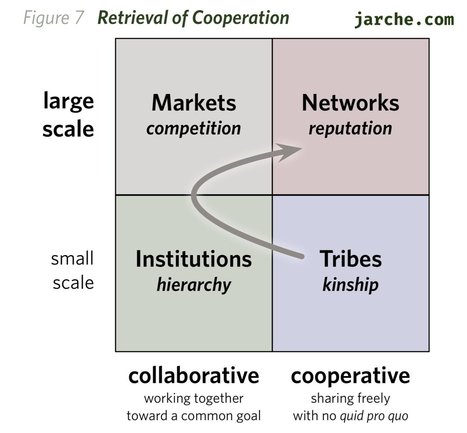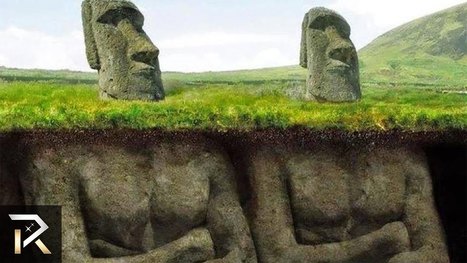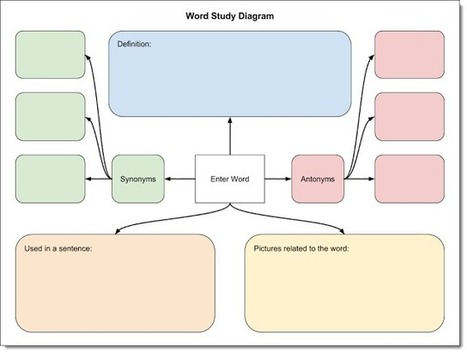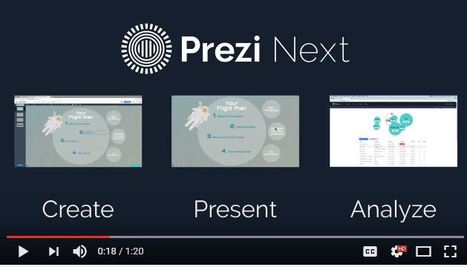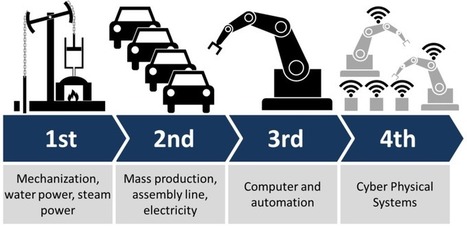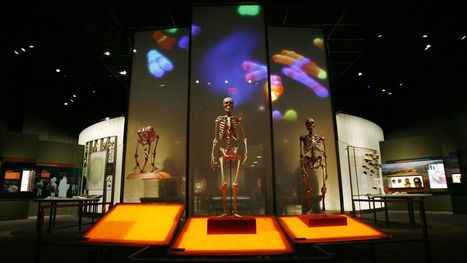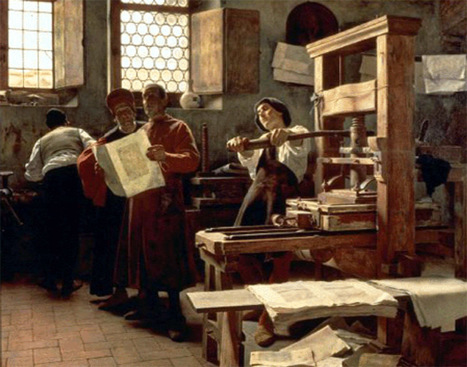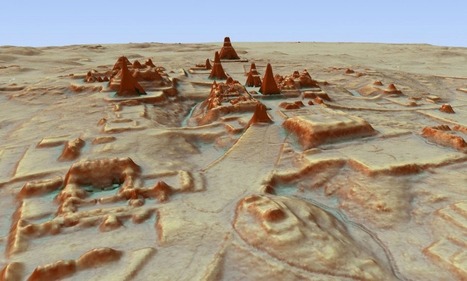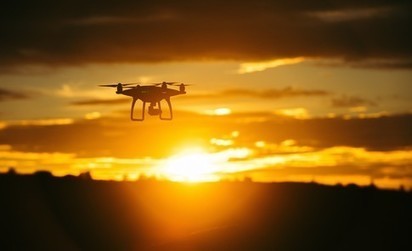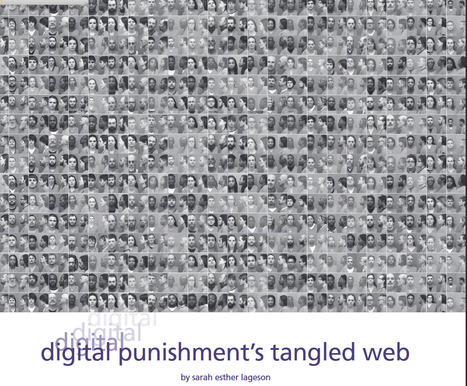 Your new post is loading...
 Your new post is loading...

|
Rescooped by
Dennis Swender
from Edumorfosis.Work
May 6, 2018 1:01 PM
|
Our societies have grown from a collection of tribes, added institutions, and later developed markets. These aligned with revolutions in communications: from oral, to written, to print. The network era began with the advent of electric communications, though it is by no means completely established.
Each type of societal structure has required different types of leadership. Alexander the Great was probably one of the best tribal leaders. He led his armies from the front and created an enormous empire. After his death, some of his generals created long-lasting institutions not based on military tactics. Ptolemy’s library at Alexandria is one example. Later, institutions like the Catholic Church dominated more through soft institutional power, rather than wielding swords. Others did that for them when necessary. As a market society developed, new types of economic and financial power were exercised by the Fuggers and the Hanseatic League in Europe. Later, captains of industry in America, such as Andrew Carnegie, would dominate in their markets, often circumventing existing institutional power.
Via Edumorfosis
In discussing individualism and collectivism it needs to be clear that this represents overall philosophical perspectives that aren't confined to simple economic or political interpretations.
Via Laurakhoury

|
Rescooped by
Dennis Swender
from Into the Driver's Seat
April 11, 2018 6:15 PM
|
Via The Scout Report "The Ancient World Online (AWOL) is a blog by Charles E. Jones, Classics and Humanities Librarian at Penn State University. AWOL is dedicated to "open access material relating to the ancient world." As Jones explains, he adapts his definition of the "ancient world" from NYU's Institute for the Study of the Ancient World (visitors will find a link to the institute at the bottom of this blog). For scholars and students interested in the classics, AWOL provides a fabulous one-stop-shop of open-access journals, digital collections, YouTube videos, articles, and other materials that may be of interest. Jones launched AWOL in 2009 and updates his blog several times a week (posting no fewer 115 times in March 2018), offering readers a remarkably extensive collection of resources."
Via Jim Lerman

|
Scooped by
Dennis Swender
April 10, 2018 11:50 PM
|
Hunter-gatherers who live off the land in the forests of Malaysia are far more in tune with their sense of smell than less mobile peoples, a new study has found. .

|
Rescooped by
Dennis Swender
from Trans Tasman Migration
April 10, 2018 12:06 AM
|
"He's unique, he's a living walking storybook," the embodiment of the bush ballads and poems.
Via Peter Mellow

|
Scooped by
Dennis Swender
April 1, 2018 12:05 PM
|
Larissa MacFarquhar on the philosopher and cognitive scientist who believes that the tools we use to help us think may be what makes human thought special.

|
Scooped by
Dennis Swender
March 11, 2018 2:54 PM
|
War deaths have increased dramatically in the modern era, new research contends, despite other statistics that suggest the risks of becoming a victim of violence have lessened
The New Industrial Revolution
During the Industrial Revolution, classrooms adopted the traditional design: desks in rows facing a chalkboard. This setup mirrored the mentality of the time, that productive information transfer happens assembly line style, from one person to the next. More than 150 years later, most classrooms still adopt this set up. Yet many scholars believe we are in the midst of a new Industrial Revolution characterized by AI, robotics, and the Internet of Things, to name a few elements. The question is, how will classrooms adapt to this new age?
Via Kim Flintoff

|
Rescooped by
Dennis Swender
from LRC Digital Resources
January 4, 2018 12:05 PM
|

|
Scooped by
Dennis Swender
November 25, 2017 12:13 AM
|
"Now, Wall Street analysts say, the retail apocalypse is upon us. Amazon dominates e-commerce and has gobbled up 5% of total U.S. retail sales. Some expect that the company will own half the online market within the next five years, a period during which, Credit Suisse predicts, a quarter of all malls will close. By the end of this year, more than 8,600 stores will have shuttered in 2017, the worst year on record."
In 2009, we were a small company introducing a big idea: that presentations didn’t have to look or behave the way we were used to. That a departure from the norm could help us communicate in more meaningful ways. That anyone anywhere could share their story and watch it grow and influence others. Today, we’re …
Via Baiba Svenca

|
Rescooped by
Dennis Swender
from Edumorfosis.it
August 14, 2017 12:55 PM
|
We’ve all heard the warning cries: automation will disrupt entire industries and put millions of people out of jobs. In fact, up to 45 percent of existing jobs can be automated using current technology. However, this may not necessarily apply to the education sector. After a detailed analysis of more than 2,000-plus work activities for more than 800 occupations, a report by McKinsey & Co states that of all the sectors examined, “…the technical feasibility of automation is lowest in education.” There is no doubt that technological trends will have a powerful impact on global education, both by improving the overall learning experience and by increasing global access to education. Massive open online courses (MOOCs), chatbot tutors, and AI-powered lesson plans are just a few examples of the digital transformation in global education. But will robots and artificial intelligence ever fully replace teachers?
Via Artur Coelho, juandoming, Edumorfosis

|
Scooped by
Dennis Swender
July 31, 2017 12:54 PM
|
Education is not preparation for life, it is life itself
|

|
Rescooped by
Dennis Swender
from Edumorfosis.Work
May 6, 2018 1:01 PM
|
Whether revolution or evolution, industrial production is all about to turn a great deal more efficient. On the flip side, production in a lot of sectors like white goods, aerospace and electronics are extremely near the standards of the third revolution.
Via Edumorfosis
A fossilized finger bone of an early human discovered in Saudi Arabia's Nefud desert is challenging long-held views about human migration out of Africa. The bone dates back to 88,000 years ago and suggests that the migration of homo sapiens out of Africa was more widespread and successful than initially believed compared to previous studies whic
Via Igor Espanhol

|
Scooped by
Dennis Swender
April 10, 2018 11:51 PM
|
Many people have become dominated by consumerism and no longer recognise the value of our natural world or the importance of community. Indigenous cultures have a lot to teach us about sharing, sustainability, and a spiritual relationship to Mother Earth, explain Freddy Treuquil and Victor Lem Masc.

|
Scooped by
Dennis Swender
April 10, 2018 11:47 PM
|
In his work "The Idea of History", philosopher and historian Robin Collingwood outlines the development of historiography by leading his audience on a European cross-continental journey through time. He identifies the early moder

|
Scooped by
Dennis Swender
April 10, 2018 12:01 AM
|
Scientists using high-tech, airplane-based lidar mapping tools have discovered tens of thousands of structures constructed by the Maya. Archaeologists have spent more than a century traipsing through the Guatemalan jungle, Indiana Jones-style, searching through dense vegetation to learn what they could about the Maya civilization. Scientists using high-tech, airplane-based lidar mapping tools have discovered tens of thousands of structures constructed by the Maya: defense works, houses, buildings, industrial-size agricultural fields, even new pyramids. The lidar system fires rapid laser pulses at surfaces and measures how long it takes that light to return to sophisticated measuring equipment. Doing that over and over again lets scientists create a topographical map of sorts. Months of computer modeling allowed the researchers to virtually strip away half a million acres of jungle that has grown over the ruins. What's left is a surprisingly clear picture of how a 10th-century Maya would see the landscape. Tags: lidar, spatial, remote sensing, geospatial, unit 1 GeoPrinciples, Guatemala, Middle America.

|
Rescooped by
Dennis Swender
from Edumorfosis.Work
March 26, 2018 11:37 AM
|
The world is changing. There’s no way around this fact.
The Fourth Industrial Revolution is now. And, whether you know it or not, it will affect you.
Billions of people and countless machines are connected to each other. Through groundbreaking technology, unprecedented processing power and speed, and massive storage capacity, data is being collected and harnessed like never before.
Automation, machine learning, mobile computing and artificial intelligence — these are no longer futuristic concepts, they are our reality.
To many people, these changes are scary.
Previous industrial revolutions have shown us that if companies and industries don’t adapt with new technology, they struggle. Worse, they fail.
Via Edumorfosis

|
Scooped by
Dennis Swender
March 8, 2018 8:34 PM
|
"Americans love crime. The criminal justice system is fetishized in popular culture and news media. We watch the news and scour the Internet to assess our own moral compass, take cues from others’ digressions, and bear witness to justice and punishment. Historically, we learned about crime through news media and fiction. The Internet has dramatically changed this landscape: for the first time, mug shots and jailhouse rosters are available with a click."

|
Rescooped by
Dennis Swender
from All digital
February 13, 2018 10:53 AM
|
People will be able to explore historical artefacts in a virtual exhibition on their smartphones.
Via Stephania Savva, Ph.D

|
Rescooped by
Dennis Swender
from Educación y TIC
December 18, 2017 10:20 AM
|
Writing a multimedia ebook or magazine can be a good way for students to illustrate and or further explain portions of fiction an
Via Mariano Fernandez S.

|
Rescooped by
Dennis Swender
from :: The 4th Era ::
September 20, 2017 9:16 AM
|
For the purposes of this Scoop.it site, the history of human interaction with information may be divided into 4 eras. The first (spoken) era ended with the invention of writing around 3000-4000 BC. The second era ended with the invention of the printing press in 1440. The third era ended, and the fourth began, with the invention of the Internet (depending how one defines its operational beginning) somewhere between 1969 and 1982. We now exist early, but decidedly, in the fourth era. All readers may not agree with this interpretation of the history of information, especially with the division and numbering of the eras. That is not the main point. Rather, it is that humankind is presently existing in an era distinctly different from the one that preceded it -- that in fact, this new era is accompanied with, and characterized by, a new - and quite different - information landscape. This new Internet information landscape will challenge, disrupt, and overpower the print-oriented one that came before it. It will not completely obliterate that which preceded it, but it will render it to a subsidiary, rather than primary, level of influence. Just as the printing press altered humanity's relationship with information, thereby resulting in massive restructuring of political, religious, economic, social, educational, cultural, scientific, and other realms of life; so too will the advance of digital technology occasion analogous transformations in the corresponding universe of present and future human activity. This site will concern itself primarily with how K-20 education in the US, and the people who comprise its constituencies, may be affected by this transformative movement from one era to the next. All ideas considered here appear, to me at least, to impact the learning enterprise in some way. Accordingly, this work looks at the present and the future through a lens that is predominantly, but far from entirely, a digital one. -JL Opinions expressed, scooped, or copied in this Scoop.it topic are my own, or a result of my own judgment, and should in no way be understood to reflect those of my employer.
Via Jim Lerman

|
Rescooped by
Dennis Swender
from Daily Magazine
August 14, 2017 12:57 PM
|
Crown shyness is a naturally occurring phenomenon in some tree species where the upper most branches in a forest canopy avoid touching one another.
Via THE OFFICIAL ANDREASCY

|
Rescooped by
Dennis Swender
from :: The 4th Era ::
July 31, 2017 1:20 PM
|
The relationship between religiousness and authoritarianism has been a topic of study in the political, psychological, and social sciences at least as far back as the 1950s. Scholars Paul Wink, Michele Dillon and Adrienne Prettyman write that “a large body of research indicates that church involvement is predictive of an authoritarian attitude constellation, characterized by deference to ‘law and order,’ social conventionality, and intolerance of out-groups.” Gary K. Leak and Brandy A. Randall note that decades of study has shown “when religion is conceptualized in unitary terms, such as church attendance or affiliation, religion often goes hand in hand” with “intolerance, prejudice, authoritarians, and dogmatism.”
These authors agree, however, that the link between religion and authoritarianism isn’t inevitable. It really depends on the kind of religion.
Via Jim Lerman
|



 Your new post is loading...
Your new post is loading...

